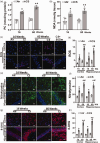Tobacco cigarette smoking induces cerebrovascular dysfunction followed by oxidative neuronal injury with the onset of cognitive impairment
- PMID: 39136181
- PMCID: PMC11572251
- DOI: 10.1177/0271678X241270415
Tobacco cigarette smoking induces cerebrovascular dysfunction followed by oxidative neuronal injury with the onset of cognitive impairment
Abstract
While chronic smoking triggers cardiovascular disease, controversy remains regarding its effects on the brain and cognition. We investigated the effects of long-term cigarette smoke (CS) exposure (CSE) on cerebrovascular function, neuronal injury, and cognition in a novel mouse exposure model. Longitudinal studies were performed in CS or air-exposed mice, 2 hours/day, for up to 60 weeks. Hypertension and carotid vascular endothelial dysfunction (VED) occurred by 16 weeks of CSE, followed by reduced carotid artery blood flow, with oxidative stress detected in the carotid artery, and subsequently in the brain of CS-exposed mice with generation of reactive oxygen species (ROS) and secondary protein and DNA oxidation, microglial activation and astrocytosis. Brain small vessels exhibited decreased levels of endothelial NO synthase (eNOS), enlarged perivascular spaces with blood brain barrier (BBB) leak and decreased levels of tight-junction proteins. In the brain, amyloid-β deposition and phosphorylated-tau were detected with increases out to 60 weeks, at which time mice exhibited impaired spatial learning and memory. Thus, long-term CSE initiates a cascade of ROS generation and oxidative damage, eNOS dysfunction with cerebral hypoperfusion, as well as cerebrovascular and BBB damage with intracerebral inflammation, and neuronal degeneration, followed by the onset of impaired cognition and memory.
Keywords: Cerebrovascular disease; free radicals; inflammation; nitric oxide; oxidative stress.
Conflict of interest statement
Declaration of conflicting interestsThe author(s) declared no potential conflicts of interest with respect to the research, authorship, and/or publication of this article.
Figures







Similar articles
-
Chronic cigarette smoke exposure triggers a vicious cycle of leukocyte and endothelial-mediated oxidant stress that results in vascular dysfunction.Am J Physiol Heart Circ Physiol. 2020 Jul 1;319(1):H51-H65. doi: 10.1152/ajpheart.00657.2019. Epub 2020 May 15. Am J Physiol Heart Circ Physiol. 2020. PMID: 32412791 Free PMC article.
-
Hippocampal nitric oxide upregulation precedes memory loss and A beta 1-40 accumulation after chronic brain hypoperfusion in rats.Neurol Res. 2003 Sep;25(6):635-41. doi: 10.1179/016164103101201931. Neurol Res. 2003. PMID: 14503018
-
Asymmetric dimethylarginine exacerbates cognitive dysfunction associated with cerebrovascular pathology.FASEB J. 2020 May;34(5):6808-6823. doi: 10.1096/fj.201901318R. Epub 2020 Apr 2. FASEB J. 2020. PMID: 32239698
-
Cigarette smoking impairs nitric oxide-mediated cerebral blood flow increase: Implications for Alzheimer's disease.J Pharmacol Sci. 2016 Aug;131(4):223-32. doi: 10.1016/j.jphs.2016.07.001. Epub 2016 Jul 16. J Pharmacol Sci. 2016. PMID: 27530818 Review.
-
Cerebral hypoperfusion and cognitive impairment: the pathogenic role of vascular oxidative stress.Int J Neurosci. 2012 Sep;122(9):494-9. doi: 10.3109/00207454.2012.686543. Epub 2012 May 24. Int J Neurosci. 2012. PMID: 22519891 Review.
Cited by
-
The Lung-Brain Axis in Chronic Obstructive Pulmonary Disease-Associated Neurocognitive Dysfunction: Mechanistic Insights and Potential Therapeutic Options.Int J Biol Sci. 2025 May 15;21(8):3461-3477. doi: 10.7150/ijbs.109261. eCollection 2025. Int J Biol Sci. 2025. PMID: 40520003 Free PMC article. Review.
-
Systemic lupus erythematosus: updated insights on the pathogenesis, diagnosis, prevention and therapeutics.Signal Transduct Target Ther. 2025 Mar 17;10(1):102. doi: 10.1038/s41392-025-02168-0. Signal Transduct Target Ther. 2025. PMID: 40097390 Free PMC article. Review.
References
-
- Caldirola D, Daccò S, Grassi M, et al. Effects of cigarette smoking on neuropsychological performance in mood disorders: a comparison between smoking and nonsmoking inpatients. J Clin Psychiatry 2013; 74: e130–e136. - PubMed
MeSH terms
Substances
Grants and funding
LinkOut - more resources
Full Text Sources

